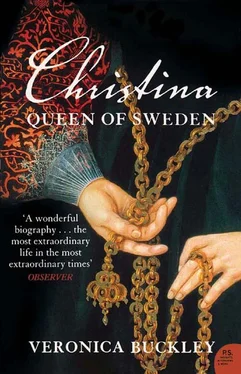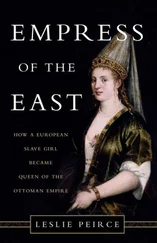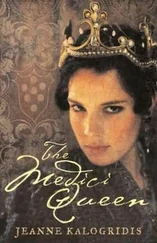In the December of 1620, the marriage took place, and three days later, before the silver altar of Stockholm’s Storkyrka, Sweden’s new Queen was crowned. Though her title was ancient, her accoutrements were new, for the former Queen, Gustav Adolf’s mother, Christine, had refused to hand over her regal insignia. In some haste, a new crown had been beaten out of gold, a new sceptre and orb provided, studded with rubies and diamonds, the red and white of the Queen’s native Brandenburg. The King was dressed in the colours of his own land, in a blue robe embroidered with gold. Liveried pages and knights in pearled helmets paid homage, as the resentful Queen Mother looked on.
Late in the summer of the following year, Maria Eleonora gave birth to a stillborn daughter. The King was away, campaigning in Livonia, 8taking advantage of a Turkish attack on southeast Poland to harangue his old enemy from the north, when the news arrived that his wife had been ‘too soon and untimely’ delivered of the child. From his camp outside Riga, he sent a grieving letter to his brother-in-law, lamenting the ‘misery’ which had befallen the Queen and stricken his royal house. ‘May God be kind to her,’ he wrote, ‘and help her quickly back to health.’ 9
Health of a kind did return to the Queen, but not quickly, and it was more than two years before she was brought to bed again, of a second daughter, who was named Kristina Augusta. ‘The little girl is doing well,’ she wrote, and in the summer of 1624, after almost four years in Sweden, Maria Eleonora’s mother decided that she and her youngest daughter could safely return to Brandenburg. But this hopeful time was not to last. In the autumn, the child fell suddenly ill, and before she had reached her first birthday, she died, an unhappy reminder of Maria Eleonora’s own three youngest siblings, all of whom she had seen die within their first year of life.
Maria Eleonora passed a sad winter, bereft of her mother and sister, her little daughter dead, and her husband, to whom she had begun to cling with a desperate fondness, too often preoccupied and too often away. In February came a further blow, the death of her younger brother, at the age of just 21. As the spring approached, happier times seemed promised; the days lengthened and a mild sun shone down, and another baby quickened in her womb. But in April, news arrived from Berlin of the Electress Dowager’s death. The Queen was deeply affected, and for some weeks she lay sorrowing and ill, mourning her mother, wearied by her pregnancy. Towards the end of May, she rallied. The King was again in Stockholm, and in the fine spring weather an inspection of the Swedish fleet was to take place in the surrounding harbour. The royal couple would attend together, reviewing the ships from aboard their own small yacht. The fleet lay at anchor off the little island of Skeppsholmen, and as the King and Queen sailed past, a sudden squall blew up around them, rocking their yacht from side to side until it almost capsized. Though the mooring was soon reached, the Queen was carried back, frightened and ailing, to her rooms in the castle, and there she endured the bitter conclusion of the day. For within a few hours, her labour had begun, too early; the morning light would break upon her weeping women, and her little stillborn son.
The King recorded the tragedy with pious resignation. ‘Disaster has befallen me,’ he wrote. ‘My wife has brought a dead child into the world. It is because of our sins that it has pleased God to do this.’ 10
For his Vasa dynasty, at least, it was indeed a disaster. In this fifth year of his marriage, and despite the Queen’s three confinements, Gustav Adolf had as yet no living heir. Three years before, his younger brother had been killed in battle in Poland, and the King of that same country, Gustav Adolf’s cousin, Sigismund III, now stood to inherit the Swedish throne. Moreover, Sweden’s enemy heir had two adult sons of his own, through whom a Catholic dynasty might be foisted upon the unwilling Swedes, raising once again the spectre of civil war.
But the lack of an heir was not the only disaster to have befallen the King. His wife’s behaviour was becoming increasingly eccentric. During his many absences on campaign, she would be ill and depressed, then would bound out of her dismal moods with cravings for sweet foods and lavish spending on gifts for her favourites which the Treasury could not afford. She had always been passionately fond of her husband, but now her attachment became obsessive, and she pleaded repeatedly with Axel Oxenstierna to persuade him to return. ‘Please help me, if you can help me,’ she wrote to the exasperated Chancellor. One courtier, describing her as ‘unimaginably’ hysterical, attributed her behaviour, sympathetically, to simple loneliness. Maria Eleonora herself felt sure of the source of her malaise. ‘When I know that my most beloved lord is coming,’ she wrote, ‘then all my sickness and panic fall away.’ 11
The Queen’s extreme behaviour was not the only sign that she was now far from well. Her very odd use of language was becoming the subject of comment by many at court. Far from having mastered the language of her adopted country, since coming to live in Sweden she had become incapable of using even her native German correctly. Whether speaking or writing, she muddled syllables and made up strange concoctions of words which resembled but did not match those of any language she had learned. Although no one regarded the Queen as intelligent, and many spoke of her extravagant flights of hysteria, her unusual difficulty with language suggests a possible neurological problem. It may be that, during one of her confinements, she had suffered some kind of stroke; certainly there was no mention of any language problem before her marriage, and her own father had suffered several strokes which had left him increasingly debilitated. Whatever the reason for the Queen’s abnormal use of language, it no doubt added to her increasing sense of desperation – even her handwriting, once straight in lines of even spacing, now showed a pronounced downward slope, the graphologist’s tell-tale sign of depression. 12
The Queen’s unhappiness can only have been increased by the knowledge that, only a few hours’ journey from Stockholm, her husband’s nine-year-old illegitimate son was living with his Dutch mother and stepfather, Margareta and Jakob Trello, at Benhammar, an estate in the King’s gift. 13The King was evidently proud of the boy; he had named him, after all, Gustav Gustavsson. His existence was no secret, and indeed, rumours abounded that the affair between the King and Margareta was still ongoing; Margareta herself had written to Gustav Adolf to reassure him that she was not the source of them. There does not seem to have been any truth in the rumours, but the boy’s bright and sturdy presence in itself must have been a constant reminder to the Queen of the son she herself still lacked.
The King, though courteous and considerate, had by now abandoned any hope of a genuine companionship with his wife. In public, he spoke of her affectionately, but in private he referred to her as his malum domesticum , a ‘domestic cross’ which he was obliged to bear. To his friends, it seemed, he regarded her as ‘more or less a child’, to be attended to and watched over, but from whom no mature, reciprocal feeling could ever be expected. Still in her twenties, Maria Eleonora had already begun to assume the sad mantle of old age, confused in her speech, prey to every illness, trying to those about her.
Further troubles now beset Gustav Adolf, for this was 1625, a plague year, and his own troops in the east had not been spared. In December came news of his mother’s death. It was late in the spring before he could return to bury her; through the long months of winter her body lay in state in Nyköping. But on his arrival, the King brought joyful news; the Queen was expecting another child. Pitying her pleading, and no doubt only too aware that an heir had yet to be produced, the King had agreed to her joining him after a Swedish victory had provided a pause in the fighting. As the year progressed, every precaution was taken to ensure Maria Eleonora’s safety, and in November, a few weeks before the expected birth of the new baby, Gustav Adolf’s illegitimate son was tactfully dispatched to the university at Uppsala, in the care of the King’s own boyhood tutor. It was not in any sense a dismissal; the young Gustav would retain his place in his father’s affections, but for now, it seems, he was best out of the way.
Читать дальше












